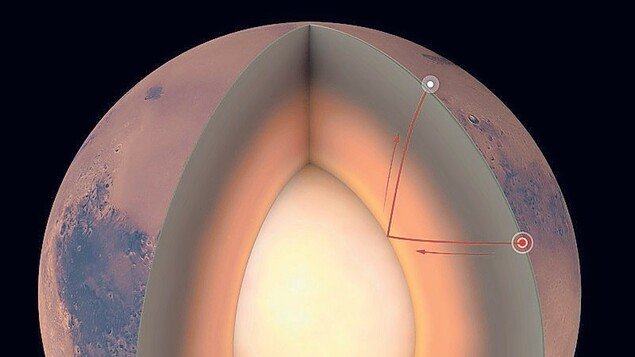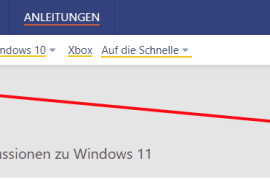In 1889, the German geophysicist Ernst von Rebeuer-Paschwitz recorded an earthquake from afar for the first time: with the help of two horizontal pendulums in Potsdam and Wilhelmshaven, he recorded an earthquake about 9,000 kilometers away in Japan. Von Rebeur-Paschwitz is considered the founder of seismology, the discipline that deals with earthquakes and the propagation of seismic waves in solids.
In the following decades, scientists used seismic measurements to determine the structure of the Earth. Background: The waves produced by the aftershocks propagate at different speeds in different layers of the subsurface. The analysis of transit times as well as some other measured values allows conclusions to be drawn about the composition of the Earth’s interior.
thick core
Thanks to such work, we now know that the Earth is made up of layers of the crust, mantle, core, and inner core. With the help of seismic measurements, researchers have now for the first time examined the internal structure of Mars, on which it also moves and for which a similar rock composition is predicted. Central result: The center of the Red Planet is larger than previously thought, but its crust is thinner than anticipated. International research teams with the participation of German scientists published their results in three papers in the specialist journal “Science“Issued.
“Models of the composition of Mars have been around for a hundred years, but little progress has been made over the decades with respect to the dimensions of the crust and core,” says co-author Martin Niemeyer, a geophysicist at the Institute for Planetary Research. at the German Aerospace Center Space (DLR). “Only seismology can directly measure these quantities. Before that, they had to be estimated from other observations.”
“insight”
The probes are part of “InSight” (Interior Exploration Using Seismic Investigations, Geodesy and Heat Transport) NASA mission launched in 2018. It aims to find out more about the composition of the planet and the dynamics beneath its surface – and thus more about its formation and evolution. “Mars and Earth are similar planets of a common origin,” explains Domenico Giardini, head of one of the research groups involved at the Swiss Federal Institute of Technology (ETH) in Zurich. “We want to understand why the two have evolved so differently. Today’s Mars could be Earth’s future.”
In November 2018, after a nearly seven-month journey to the planet, the “InSight” space probe touched down in the Elysium Planitia region north of the equator. A few weeks after landing, she used a robotic arm to lift a seismometer (SEIS; Seismic Experiment for Interior Structure) on the floor of Mars. Scientists presented the first analysis last year. They showed that Mars is seismically active – something that had not been conclusively proven before. The planet is shaking much more often than expected, about once a day. None of the earthquakes assessed at that time reached a magnitude of more than 4 – such vibrations are hardly noticeable without measuring instruments on Earth.
coolant earthquake
Martian earthquakes do not occur on Earth as a result of plate tectonics, that is, the movement of the seven continental plates. According to current knowledge, there is only one large continental plate on Mars. The earthquakes there are the result of cooling. “The cooling processes create tension between the crust and the mantle, which loosens and then creates vibrations,” explains ETH researcher Amir Khan. To date, SEIS has recorded about 700 earthquakes on Mars. In their current work, the researchers examined about ten earthquakes that originated under the Martian crust. Most earthquakes on Mars occur within the crust.
Analyzing earthquakes on Mars is a challenge in many ways: on the one hand, “InSight” with SEIS put only one seismometer on the planet that records vibrations in one place. Although the device’s sensitive sensors measure the propagation of vibrations in three directions and at different frequencies, it is difficult to trace the origin of the earthquake. Changes in atmospheric pressure or storms also have an effect on the sensors – they generate noise that has to be isolated to analyze earthquake signals. “We now understand very well what the signals in everyday images mean,” says ETH researcher Simon Stahler. For example, wind and gusts can be easily distinguished from earthquake signals.
Large radius, low density
The scientists analyzed, among other things, the so-called P and S waves that travel through the planet after the Martian earthquake, as well as after the earthquake. P waves (primary waves) vibrate in the direction of propagation; They move faster than S waves (secondary waves), which vibrate transversely in the direction of propagation. The different arrival times on the seismometer help in locating the location of the earthquake. Since the waves are bent or reflected at layer boundaries, such as the boundary between the mantle and the core, they also provide information about the planet’s internal structure.
Stahler and his team focused on the center of Mars. Among other things, they used the fact that S waves are reflected by a liquid core and sent back through the Mars mantle: they give off particularly strong echoes. The measurements showed that the Mars core has a diameter of about 3700 meters and is therefore surprisingly large.
“If the core radius is large, then the density of the core should be relatively low,” explains Stahler. “In addition to iron and nickel, the core should also contain a large proportion of lighter elements.” Sulfur, oxygen, carbon and hydrogen are possible alternatives. According to the researchers, at least at its outer edge, the core is liquid, but the planet today does not have a magnetic field.
thin crust
To study the mantle structure, Khan’s team analyzed P and S waves that traveled directly from the origin of the earthquake to the seismometer or were reflected from the planet’s surface. From this he gained knowledge about Mars at a depth of up to 800 km. Its lithosphere – a hard layer of rock – is about 500 kilometers thick and about 250 kilometers thicker than Earth’s. “The thicker lithosphere fits well with the model of Mars as a ‘one-plate planet’,” says Khan.
A team led by Brigitte Napmayr-Andron (University of Cologne) focused on the Red Planet, the outermost layer of the crust. The previous estimate of their thickness was between 9 and 90 km. The measurements now provide more concrete figures. First, the researchers measured the thickness of the crust directly below the “InSight” landing site. They narrowed the thickness there to 20 or 39 kilometers, which was thinner than many previous measurements.
Taking into account the planet’s topography and using global maps of the gravitational field, the team determined the average thickness of Mars’ crust for the entire planet. So it is between 24 to 72 kms. The thickness of the crust also says something about its chemical composition: if it is thin, it must contain a high proportion of radioactive elements. It derives from models that show the history of the planet’s formation and evolution, as the Swiss researchers point out.
descending line
The example shows that with new information on the composition of the planet, the real challenge lies before scientists: reconciling the information with previous ideas about the history of Mars’ formation – or developing new ideas. How did the light element get into the core, which should now be based on the determined shape? Was the planet formed at the same time and of the same material as Earth? These and many other questions are still awaiting answers. “But we are very far away with evaluating all the data. Mars still presents us with many puzzles,” Giardini says.
In about a year, the space probe’s solar cells probably won’t be able to supply enough power to ensure measurement and data transmission. Until then, the seismometer will in all likelihood record dozens more earthquakes – and thus provide further material for further investigation. Anja Garms / DPA

Internet fan. Alcohol expert. Beer ninja. Organizer. Certified tv specialist. Explorer. Social media nerd.





